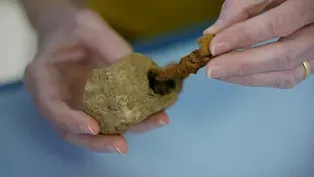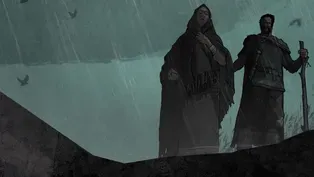
Identifying Biological Sex from Skeletal Remains
Clip: Season 21 Episode 2 | 2m 7sVideo has Closed Captions
Two experts conduct a virtual autopsy on skeletal remains from Roman Britain.
Corinne Duhig and Ben Garrod perform a virtual autopsy on Skeleton 4926, whose remains date to the time of the Roman occupation of Britain. Corinne, an osteoarchaeologist, and Ben, a biologist and her former student, inspect a number of features that can help indicate biological sex. Based on the angle of the pelvic bone and a defined brow ridge, they are confident the skeleton is male.
Problems with Closed Captions? Closed Captioning Feedback
Problems with Closed Captions? Closed Captioning Feedback
SECRETS OF THE DEAD is made possible, in part, by public television viewers.

Identifying Biological Sex from Skeletal Remains
Clip: Season 21 Episode 2 | 2m 7sVideo has Closed Captions
Corinne Duhig and Ben Garrod perform a virtual autopsy on Skeleton 4926, whose remains date to the time of the Roman occupation of Britain. Corinne, an osteoarchaeologist, and Ben, a biologist and her former student, inspect a number of features that can help indicate biological sex. Based on the angle of the pelvic bone and a defined brow ridge, they are confident the skeleton is male.
Problems with Closed Captions? Closed Captioning Feedback
How to Watch Secrets of the Dead
Secrets of the Dead is available to stream on pbs.org and the free PBS App, available on iPhone, Apple TV, Android TV, Android smartphones, Amazon Fire TV, Amazon Fire Tablet, Roku, Samsung Smart TV, and Vizio.
Buy Now

Providing Support for PBS.org
Learn Moreabout PBS online sponsorshipBen and Corinne begin by looking at the basics: the biological sex and age of 4926.
But when dealing with a centuries-old skeleton, nothing is straightforward.
-I think the big question for me first of all is: male/female?
I mean, it's not always easy.
-It's not always easy.
We've got to do it by lots of different features around the body.
And we're looking primarily at the pelvis because that's primary sexual dimorphism.
In other words, that's what changes at puberty.
So this area here, this is called the sciatic notch, because this is where the sciatic nerve passes through.
In a male, it will stay in the narrow form, as you would find in a child.
but in the female it grows at puberty, it opens out to make the pelvis bigger.
-I remember you teaching me years ago, there's something to do with the actual angle and you can measure it against your fingers as a very loose estimation.
If it's a certain angle, it's male.
If it's a slightly bigger, it's female.
-In females, the angle will be more than 90 degrees and can be very, very large indeed.
What we're seeing here is a little bit smaller than a right angle, only just a bit smaller.
It is slightly more in the male area of his pelvis.
-Okay.
-So that's a good start for us.
-But that's not, that's not the whole picture, as you say.
The skull is very important for helping determine male or female.
-So, first of all, let's look at his frontal bone, immediately above the root of the nose.
And you can see that you've got this heavy bulge on the frontal bone.
So this is the real, sort of, "Arnold Schwarzenegger" brow ridge.
-So I would typically have a brow ridge, being a big, dominant, strapping... -Dominant primate!
-male.
(both laughing) -And you wouldn't typically see one as accentuated, or even really present, in, in yourself, for example.
-Yeah, that's absolutely true.
And, in fact, I have no brow ridge, having seen my own X-rays.
-You've said male a few times.
Are you confident this is a man?
-Absolutely confident.
He's coming out as male, or probably male, in every one of the features that we can score.
Competing Theories for Nail Found in Heel Bone
Video has Closed Captions
An osteoarcheologist explores possible explanations for a nail found through a heel bone. (1m 2s)
Video has Closed Captions
Uncover the only evidence of crucifixion in Roman-occupied Britain. (32s)
Providing Support for PBS.org
Learn Moreabout PBS online sponsorshipSupport for PBS provided by:
SECRETS OF THE DEAD is made possible, in part, by public television viewers.













